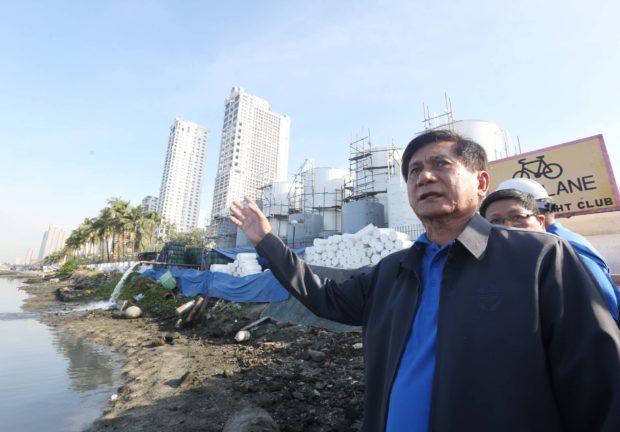DENR cites gains in Manila Bay cleanup
MANILA, Philippines — The waters of Manila Bay, world-famous for its sunset, have shown signs of improvement a year after the environment department and other government agencies launched a drive to clean up what has been called a “gigantic septic tank.”
Officials touted Baseco Compound, a huge slum by the bay in Tondo, Manila, as one of the biggest triumphs of efforts at restoring the old glory of the bay, where Commodore George Dewey destroyed the Spanish Pacific Squadron during the Spanish-American War.
Not too long ago, the water at the shoreline of Baseco was filled with trash—from plastic food packaging and sachets to used diapers.
Now, the sand underneath the water is finally visible, after months of consistent cleanup activities led by the Department of Environment and Natural Resources (DENR) and village officials.
High court mandamus
Saying he was “impressed” by the agencies’ efforts, Chief Justice Diosdado Peralta said this was the first time he had seen the continuing mandamus issued by the Supreme Court in 2008 actually being implemented in the bay.
Article continues after this advertisementActing on a petition filed in 1999 by residents of the bay—University of the Philippines law students and colleagues of environment lawyer Tony Oposa, the high court ordered 13 agencies to clean up and protect the body of water.
Article continues after this advertisementThe 1,994-square-kilometer bay has a coastline of 190 km and is bounded by Metro Manila and the provinces of Cavite, Bulacan, Pampanga, and Bataan.
But much remains to be done in cleaning up the bay, Environment Secretary Roy Cimatu said on Sunday, the first anniversary of the “Battle for Manila Bay” cleanup campaign.
Levels of fecal coliform, or bacteria from human and animal feces, are still at thousands to millions most probable number per 100 milliliter (mpn/100 ml), although this was a significant decrease compared to previous levels that reached billions.
Drop in fecal coliform levels
Before the rehabilitation program, the DENR said it aimed to reduce the fecal coliform level of the bay from 330 million mpn/100 ml to a more acceptable 270 mpn/100 ml by the end of 2019.
The safe level for water quality is pegged at 100 mpn/100 ml.
While Baseco Beach has shown huge improvement visually, environment officials said it was still not safe to swim in.
While levels of coliform from three monitoring stations in Baseco still fluctuate, it still had high levels, with the lowest reaching around 30,000 mpn/100 ml, said Jacqueline Caancan, executive director of DENR National Capital Region.
But children found no problem skinny dipping into its murky brown waters on Sunday, paying no attention to the stink still emanating from the bay.
“They will feel bad when you tell them off,” said Diana Espinosa, chair of Baseco Compound. “When it was still dirty, they were already swimming there. Now that it’s clean, how will we tell them not to do so?”
While Cimatu had promised that Manila Bay would be swimmable by end of 2019, he said the timeline had been pushed back due to delays in constructing flood control projects in the bay walk area.
Treatment plants
Officials are now pinning their hopes on a new solar-powered sewerage treatment plant on Roxas Boulevard—a project of the Metropolitan Manila Development Authority.
With six main treatment tanks, the plant is expected to treat 500,000 liters of wastewater daily.
The untreated water will come from three drainage outfalls, namely Padre Faura, Rajah Soliman and the Manila Yacht Club. Once flowing straight to the bay, the outfalls will be diverted by a 1.5-km pipe stretching from the US Embassy to the yacht club.
The plant is expected to be fully operational by March.
Yet even without the treatment plant, Cimatu said recent data from the Environmental Management Bureau already showed that coliform levels from these outfalls had “drastically decreased.”
For instance, the count at Padre Faura outfall is now down to 920,000 mpn/100 ml, from its pre-rehabilitation level of 7.21 million mpn/100 ml.
At the Rajah Soliman drainage, levels went down from 35 million mpn/100 ml to 11 million mpn/100 ml.
Cimatu said some 40,000 informal settler families within the Manila Bay region would be relocated within the year.
Relocation of slums is part of the second phase of the rehabilitation plan for Manila Bay.
“Before, no one really believed that Manila Bay can be cleaned,” Peralta said. “My wife suggested that the theme song of Baseco was ‘Impossible Dream’ because it is impossible to clean.”
“But now, it’s ‘What A Wonderful World,’” the chief magistrate said, referring to Baseco’s transformation. INQ
